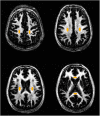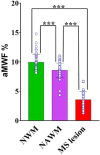Quantitative myelin water imaging using short TR adiabatic inversion recovery prepared echo-planar imaging (STAIR-EPI) sequence
- PMID: 37840897
- PMCID: PMC10568074
- DOI: 10.3389/fradi.2023.1263491
Quantitative myelin water imaging using short TR adiabatic inversion recovery prepared echo-planar imaging (STAIR-EPI) sequence
Abstract
Introduction: Numerous techniques for myelin water imaging (MWI) have been devised to specifically assess alterations in myelin. The biomarker employed to measure changes in myelin content is known as the myelin water fraction (MWF). The short TR adiabatic inversion recovery (STAIR) sequence has recently been identified as a highly effective method for calculating MWF. The purpose of this study is to develop a new clinical transitional myelin water imaging (MWI) technique that combines STAIR preparation and echo-planar imaging (EPI) (STAIR-EPI) sequence for data acquisition.
Methods: Myelin water (MW) in the brain has shorter T1 and T2 relaxation times than intracellular and extracellular water. In the proposed STAIR-EPI sequence, a short TR (e.g., ≤300 ms) together with an optimized inversion time enable robust long T1 water suppression with a wide range of T1 values [i.e., (600, 2,000) ms]. The EPI allows fast data acquisition of the remaining MW signals. Seven healthy volunteers and seven patients with multiple sclerosis (MS) were recruited and scanned in this study. The apparent myelin water fraction (aMWF), defined as the signal ratio of MW to total water, was measured in the lesions and normal-appearing white matter (NAWM) in MS patients and compared with those measured in the normal white matter (NWM) in healthy volunteers.
Results: As seen in the STAIR-EPI images acquired from MS patients, the MS lesions show lower signal intensities than NAWM do. The aMWF measurements for both MS lesions (3.6 ± 1.3%) and NAWM (8.6 ± 1.2%) in MS patients are significantly lower than NWM (10 ± 1.3%) in healthy volunteers (P < 0.001).
Discussion: The proposed STAIR-EPI technique, which can be implemented in MRI scanners from all vendors, is able to detect myelin loss in both MS lesions and NAWM in MS patients.
Keywords: EPI; STAIR; aMWF; multiple sclerosis; myelin water imaging.
© 2023 Shaterian Mohammadi, Moazamian, Athertya, Shin, Lo, Suprana, Malhi and Ma.
Conflict of interest statement
The authors declare that the research was conducted in the absence of any commercial or financial relationships that could be construed as a potential conflict of interest.
Figures





Similar articles
-
Myelin water quantification in multiple sclerosis using short repetition time adiabatic inversion recovery prepared-fast spin echo (STAIR-FSE) imaging.Quant Imaging Med Surg. 2024 Feb 1;14(2):1673-1685. doi: 10.21037/qims-23-1021. Epub 2024 Jan 18. Quant Imaging Med Surg. 2024. PMID: 38415151 Free PMC article.
-
Myelin Imaging in Human Brain Using a Short Repetition Time Adiabatic Inversion Recovery Prepared Ultrashort Echo Time (STAIR-UTE) MRI Sequence in Multiple Sclerosis.Radiology. 2020 Nov;297(2):392-404. doi: 10.1148/radiol.2020200425. Epub 2020 Aug 11. Radiology. 2020. PMID: 32779970 Free PMC article.
-
Myelin water imaging using a short-TR adiabatic inversion-recovery (STAIR) sequence.Magn Reson Med. 2022 Sep;88(3):1156-1169. doi: 10.1002/mrm.29287. Epub 2022 May 25. Magn Reson Med. 2022. PMID: 35613378 Free PMC article.
-
Brain ultrashort T2 component imaging using a short TR adiabatic inversion recovery prepared dual-echo ultrashort TE sequence with complex echo subtraction (STAIR-dUTE-ES).J Magn Reson. 2021 Feb;323:106898. doi: 10.1016/j.jmr.2020.106898. Epub 2020 Dec 28. J Magn Reson. 2021. PMID: 33429170 Free PMC article.
-
Using myelin water imaging to link underlying pathology to clinical function in multiple sclerosis: A scoping review.Mult Scler Relat Disord. 2022 Mar;59:103646. doi: 10.1016/j.msard.2022.103646. Epub 2022 Jan 30. Mult Scler Relat Disord. 2022. PMID: 35124302
References
Grants and funding
LinkOut - more resources
Full Text Sources
Research Materials

